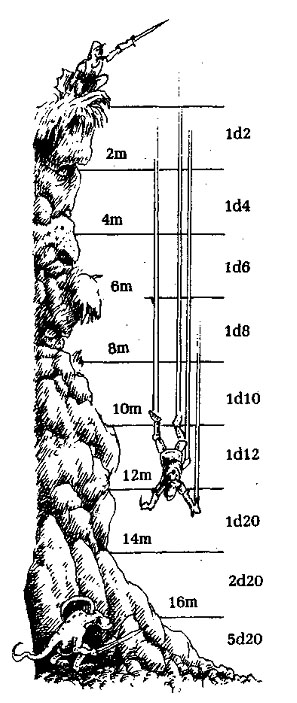If the the landing doesn’t get you (5d20? Ouch!) the sneaky Kobold will.
Let’s talk monsters.
Book One of Dragon Warriors gives stats for 46 different critters covering all the staple fantasy bases (Orc, Goblins, Dragon, Zombies, etc) as well as throwing few few more unusual beasties into the mix. My favourite new monster is the Volucreth – jungle-dwelling beak-headed Barbarians. I mean – what’s not to love?! As this is the land of old-school gaming, each monster gets a single statblock (unlike 4e’s lovely multiple blocks per monster), and you’re encouraged to tweak and customize to your heart’s content. Somehow Book One manages to pack into it’s tiny covers complete Random Encounter Tables and sample character stats for all levels from 1st to 12th (about as high as Dragon Warriors can reasonably go) too, meaning it’s usable from the get-go for spur-of-the-moment gaming. I used to take the first three books with me every family holiday, slipping them inside the edge of the suitcases, and always managed to find someone to game with while we were away. Do that with D&D and you risk going over the weight limit. I know. I’ve tried.
46 monsters might not seem like a lot in this day and age where a couple of Dragon articles could contain a similar number and Monster Manuals are filled with hundreds of critters, but this is a case where less really is more. Give me ten different monsters and I can populate a region with enough gaming goodness for months. Give me 200 and it’s hard to know where to begin. Don’t get me wrong – I love monsters, and the Monster Manuals (and their non WoTC varietys like the Monsternomicon and Tome(s) of Horrors) are my favouritest game supplements – but it’s worth remembering that every single critter doesn’t need to be in every single campaign world.
This is something Wizards’ needs to learn too. The Forgotten Realms doesn’t need Dragonborn as a native player race, and it’ll be all the weaker for it. Uniqueness comes from knowing what to take out as much as what to add in. If a player wants to be a Dragonborn in your Realms game, let him be a unique being pulled through a plana wormhole or something. This makes the player feel special, and retains the flavour of the Realms too. Subtraction is a Good Thing when world building. But that’s another post for another time, eh?
Back to Dragon Warriors. Each book added more monsters to the mix, and every adventure gave us something special too. Back in Book One, “The King Under the Forest” puts the players in an encounter with Tapestry Warriors who step out of a tapestry behind the players and attack with all-too-solid cloth shortswords. That’s so balls-achingly old school!
Book Two gives us the magical professions – the Sorcerer and Mystic – as well as the rules for Treasure and items Magic and Wondrous, with two full scenarios giving us yet more monstery goodness. In “Hobb’s Dell” there’s Zombies aplenty and a powerful Barrowwight to contend with, and “Hunter’s Moon” pits the players against Moon Dogs, Spectres and Skeletons. As is typical with Dragon Warriors, each scenario is short and designed to be played in a single session. They’re an exercise in perfect minimalism that all game designers should study. More on the adventures another time, though.
Dragon Warriors is a classic role-playing game released in 1985 as 6 trade paperback books. It is now available for free download. Happy Dragon Warriors Week!





One Comment on “Dragon Warriors Week Day Three”